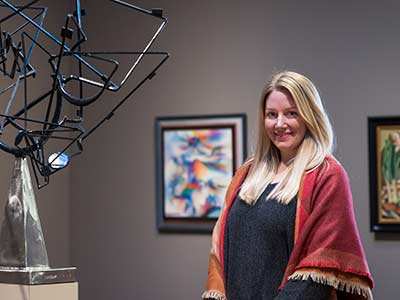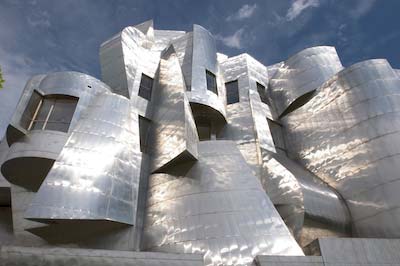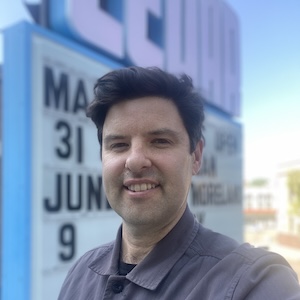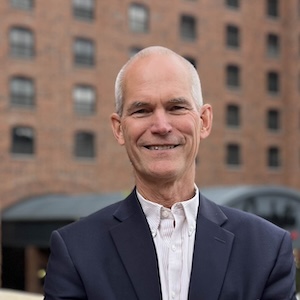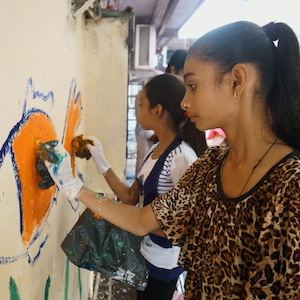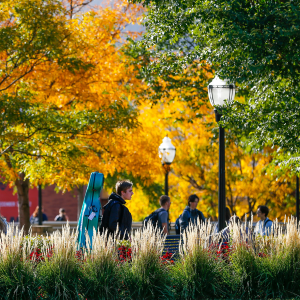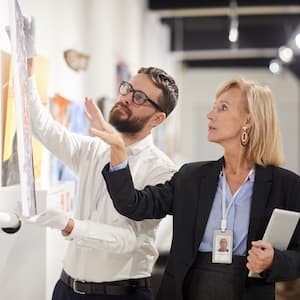Katie Covey
Katie Covey’s senior thesis as an undergraduate English literature major involved studying the journals of conquistadors traveling to the Americas. During her work, she was struck by the Waldseemüller globe map where the word "America" first debuted and the power of the written word. “Studying in Anderson Library’s James Ford Bell map room,” she recalls, “it struck me how museums have archives, and I started wondering what was in the Weisman Art Museum’s archives, and if they had ever been processed.”
Self-starter
Later that year, Covey, Erik Moore (head of University Archives), and two other graduate interns processed around 125 boxes of historical material about the Weisman Art Museum (WAM) from 1930-93. This undertaking, which became known as the WAM Files project, aimed to make the museum’s curatorial, educational, and administrative records, drawings, and correspondence accessible to the public.
That project catapulted her into a full-time position as a project manager. There, she started an initiative called WAM Collective, which is now a key component of the museum’s student engagement program.
“Weisman was really my first museum,” the Good Thunder, Minnesota native says. “It had a profound effect on me.”
It’s that lasting impact that drew Covey to the Master of Professional Studies in Arts and Cultural Leadership program. She wanted to delve into the critical theory and practice of museums while developing her leadership and outreach skills. Through the degree, she was able to serve on the boards of both the Children’s Museum and the Cycling Museum of Minnesota—all while working full-time. Challenging, she says, but “definitely manageable.”
Creating Entry Points
Today, Covey is the Weisman’s Director of Student Engagement where she focuses on integrating the arts and the Weisman collections into curricula across disciplines, collaborating with faculty throughout the University.
"I’m continuously looking for ways to make art accessible to the campus community.”
“I’m passionate about creating new entry points for nontraditional audiences to enter the museum field. The Collective produces about 17 public programs throughout the academic year, from open mic nights to concerts and artist workshops. I’m continuously looking for ways to make art accessible to the campus community.”
The campus community is 60 thousand students strong, not including staff and faculty. The audience is there, but how do you get them to visit? “One of our challenges is that we are a nondegree granting unit. We’re not part of any other department, so if they’re not engaged with us directly, they may not ever enter the doors.”
Covey’s job is to illustrate those potential relationships for stakeholders, then turn them into reality. “Making interdisciplinary connections is the most exciting thing about being at a university museum,” she says. “The students in the Collective are really inspiring; they are doing amazing work in engineering, art, philosophy, English, math, etc.—they bring what they are learning in class and we apply those ideas to our discussions and program development.”
Museums as a Place for Healing
Covey sees the role of museums evolving in an exciting direction. She aims to build student and community engagement by expanding access points through “new interpretive strategies that elevate community voices.”
Museums, Covey believes, are special places to hold conversations and host programs that can create social change. “Art is beyond language; it can bring people together to think above and beyond themselves in abstract and concrete ways.”
She points to an exhibit that is currently on display at the Weisman called Vanishing Ice, in which multiple researchers and artists depict the decline of the polar ice caps over the past 150 years. It is a visual representation of the increase of carbon dioxide in the atmosphere. Recently the Trump administration stopped funding the National Science Foundation program that was making that data public. “Each day our staff has been updating the CO2 level, and now that data is not available.”
"Museums have to stay nimble, experiment with new engagement strategies and collaborate with their communities.”
“Museums can be a space for healing,” she continues, “and I want to foster that here in the Weisman. As both the landscape and definition of culture is expanding—museums have to stay nimble, experiment with new engagement strategies and collaborate with their communities.”
Pro Tip for Students
“What is the problem in the world that you feel the most passionate about, and how can you work towards being a part of the solution? Find your passion and go after that; it won’t feel like work.“

